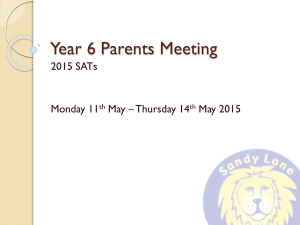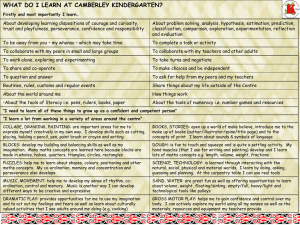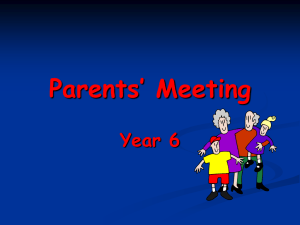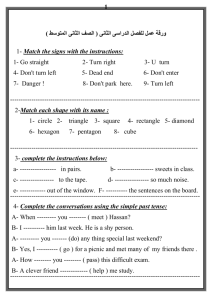Maximising engagement and knowledge transfer in large classes
advertisement
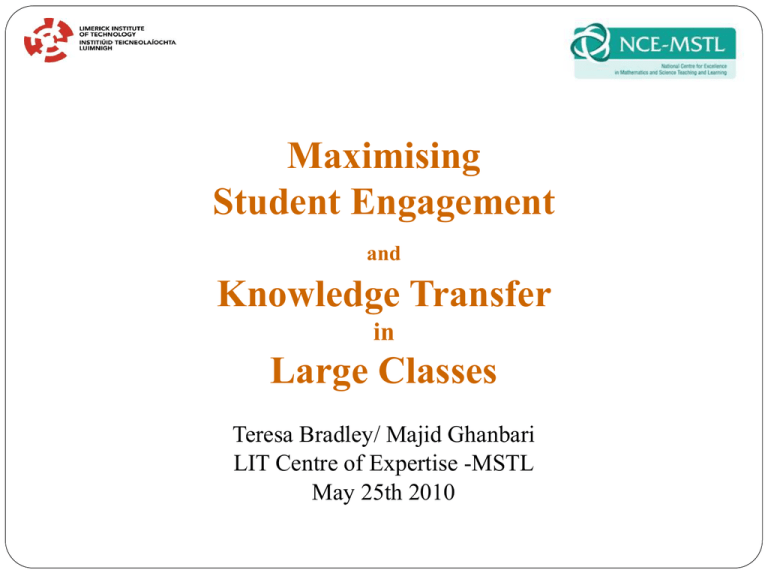
Maximising Student Engagement and Knowledge Transfer in Large Classes Teresa Bradley/ Majid Ghanbari LIT Centre of Expertise -MSTL May 25th 2010 Challenges for the IoT sector Transition to third level Most students have ordinary level mathematics Maths skills are weak (from diagnostic tests) Students tend to be active learners Large classes, particularly first year Transition to Third level (survey 2000, TB) Findings included… 52.2% found lectures difficult to understand 63% found understanding certain subjects difficult 45% like practicals But students had little time to study because Travel home every weekend (58% live away from home) Part-time work (58% work part-time) Social life 77.6% expect a full time course to be no more than 9.00- 5.00 Monday to Friday Retention linked to LC maths (p < 0.05) Table A.4(a): LC_M ATHS * Results (S & A) Crosstab ulation for cert/diploma/deg ree co urses Resul ts (S & A) pass LC_MATHS A (pass) B (pass) C (pass) D (pass) E (pass) A (hons) B (hons) C (hons) D (hons) Total 83 84.7% 141 72.3% 103 65.6% 49 67.1% 2 100.0% 3 100.0% 6 75.0% 15 88.2% 18 78.3% 420 72.9% not pass 7 7.1% 28 14.4% 29 18.5% 15 20.5% left or did not sit 8 8.2% 26 13.3% 25 15.9% 9 12.3% 1 12.5% 1 5.9% 2 8.7% 83 14.4% 1 12.5% 1 5.9% 3 13.0% 73 12.7% Total 98 100.0% 195 100.0% 157 100.0% 73 100.0% 2 100.0% 3 100.0% 8 100.0% 17 100.0% 23 100.0% 576 100.0% Retention linked to ‘Difficulty with certain subjects’ p < 0.00005 Table A.8: Difficulty with Certain subj ects * Results (S & A) Crosstabulation Results (S & A) Certain subjects very difficult difficult not difficult Total pass 153 63.8% 168 77.4% 219 80.2% 540 74.0% not pass 47 19.6% 27 12.4% 27 9.9% 101 13.8% left or did not sit 40 16.7% 22 10.1% 27 9.9% 89 12.2% Total 240 100.0% 217 100.0% 273 100.0% 730 100.0% Diagnostic tests 2008_09 and 2009_10 Some results for STEM courses 2008: n = 382 (complete details) 2009: n = 341 (complete details) Test consists of three sections.. Numeracy, Algebra, Trigonometry 1 mark for correct answer. 0.5 marks for method and no more than one minor mistake. Mark scheme (maximum marks 6 per section ) Marks 5.5 to 6 Inclusive (Green): competent in basic skills – keep it up Marks ranging from 3 but less than 5.5 (Amber): there are serious gaps in basic skills. Marks less than 3 (Black): there are very serious gaps in basic skills.. Comparison of average results 08_09 vs. 09_10 Numeracy Algebra Trigonometry 2008 3.61 3.13 2.96 2009 3.44 2.78 2.52 Data from diagnostic tests 08_09 LC Grades (Ord) 2008, 2009 2009 2008 20.00% 18.00% 16.00% 14.00% 12.00% 10.00% 8.00% 6.00% 4.00% 2.00% 0.00% A1 A2 B1 B2 B3 C1 C2 C3 D1 D2 D3 Lower cognitive skills are weak (Blooms Taxonomy) Remembering… Understanding Applying For example, Section 2: Algebra (n = 382) 7. Evaluate b b 2 4ac 2a when a = 1, b = - 3 and c = - 4 44.04% correct 08 8. Rearrange the following formula: in the form T=? PV nR T 44.76% Correct 08 9. Write the following as a single fraction 1 1 R1 R2 16.54% Correct 08 Learning Styles Profiling (Dr M O’Brien, LIT) Visual vs. Verbal Active vs. Reflective. Sensing vs. Intuitive Global vs. sequential Different Learning styles Report on Learning Styles Profiling (Dr M O’Brien) LIT n = 316 LIT n = 316 Active 61.39% Verbal 20.25% Reflective 38.61% Visual 79.75% Intuitive 23.10% Global 41.46% Sensing 76.90% Sequential 58.54% Active learning Getting students to do something course- related other than watching and listening to the instructor (Felder 2008). Active learning Active learning occurs when the learner organises selected information into coherent mental representations, and integrates it with prior knowledge. (Mayer 1999) Active Learning Good Practice Encourages Active Learning. Learning is not a spectator sport. Students do not learn much just sitting in classes listening to teachers, memorizing pre-packaged assignments and spitting out answers. They must talk about what they are learning, write about it, relate it to past experiences. I ask students to present their work in class. I ask my students to relate outside events or activities to the subjects covered in my courses. I encourage students to challenge my ideas, the ideas of other students, or those presented in readings or other course materials. I give my students concrete, real-life situations to analyze. I encourage students to suggest new readings, projects, or course activities. Chickering and Gamson, "Seven Principles for Good Practice in Undergraduate Education," AAHE Bulletin, March 1987 Active teaching a. Recognize the different learning styles. b. ‘Instruction begins when you’ the teacher, learn from the learner. Put yourself in his/her place so that you may understand what her learns and the way s/he understands it (Kierkegaard) Current Initiatives Practicals Practical exams constitutes 15%- 30% of many maths courses Moodle Learning Support The Challenge of Large ClassesSome active learning techniques TAPPS (thinking aloud pair problem solving)… n Short problems (30 sec to 3 min) n Longer problems… circulate, give hints and check understanding Give handouts with gaps Use of classroom response systems – being researched at present Research in the effective use of ICT LIT Centre of Expertise in Mathematics and Science Teaching and Learning (Oct. 2009) Two post graduate students Majid Ghanbari (Maths) Regina Kelly (Science) …a distributed centre of NCE-MSTL Initial trials on ‘Clickers’ are very positive Project Outlines To develop an innovative classroom engagement technique and use technology for the enhancement of teaching and learning of mathematics with emphasis on IoT sector Majid Ghanbari Educational Goals To maximise interactivity between lecturers, students and the learning materials Raising interest and motivation in students To enhance the learning experience To establish students’ basic maths skills and challenge them to think critically (Blooms taxonomy) Maximization of transfer of learning Formative Teaching (Active Teaching) Professor John Hattie showed that feedback had more impact on learning quality than any other single factor. Sadler '89 analysed feedback to show that for learning to take place the learner needs to know: The Goal Student’s present position How to close the gap http://www.teacherstoolbox.co.uk Cambridge Regional College Good-Questions It is a pedagogical strategy that aims to raise the visibility of the key concepts and to promote a more active learning environment. Such questions stimulate students’ interest and curiosity in mathematics offer students frequent opportunities to make conjectures and argue about their validity; reflect the role of students’ prior knowledge and misconceptions in building conceptual understanding provide instructors with frequent formative assessments of what their student are learning; support instructors efforts to foster an active learning environment http://www.math.cornell.edu/~GoodQuestions/ Maria Terrell, PI, Robert Connelly Co-PI Good questions build progressively… Quick check: Designed to quickly check students' basic understanding of the material Probing: Usually requires some thought and extension beyond basic concepts Deep: Difficult questions that will usually require instructor intervention to help guide students in the right direction http://www.math.cornell.edu/~GoodQuestions/ Maria Terrell, PI Robert Connelly Co-PI Example of a Quick-check Question 5x dx 4 (a) x c 5 (b) 20x3 c 1 5 (c) x c 5 equals Example of a probing Question x (a) (b) (c) 1 x c 3 2x c 1 c x (d) Both (a) and (c) 2 dx equals Example of a deep Question x dx 1 (a) x 2 c (b) 1 c x (c) Ln( x) c (d) Doesn’t exist equals Classroom Response Systems (clickers) • Allows for two-way communication between an instructor and students regardless of the size of a class • Instructors receive instant feedback on understanding and misconceptions of the whole class instead of relying on responses of few who are willing to speak out • Students receive instant feedback regarding their understanding, comparing themselves to the rest of the class and consequently building their confidence Q4 Q5 Q5 Instructor’s handset http://www.qwizdom.co.uk Question Types Multiple Choice -You can have up to 6 choices (A,B,C,D,E,F) Yes/No True/False Numeric Sequence Multiple Mark Rating Scale Vote (Multiple Mark) Text Input This is a text input question, only available for the Q5 remotes, this allows for up to 30 characters in the answer. Demographic Public Response Graph Excel Report Flash Reports Research to Date Literature review Familiarisation with technology Decided that the clickers satisfy the educational goals and are suitable for large classes Clickers have been piloted in a 1st year electronics engineering class (app. 80 students) Next..... Design slides (Good Questions) for selected topics in 1st year engineering maths Implementation in semester one, 2010 Evaluation The Independent (UK) 5 January 2009 -a study by the KPMG foundation ‘Numeracy difficulties are linked to … exclusion from school health risks (more likely to suffer from depression) increased involvement with the criminal justice system. Legal costs £164.8m a year… Thank you





